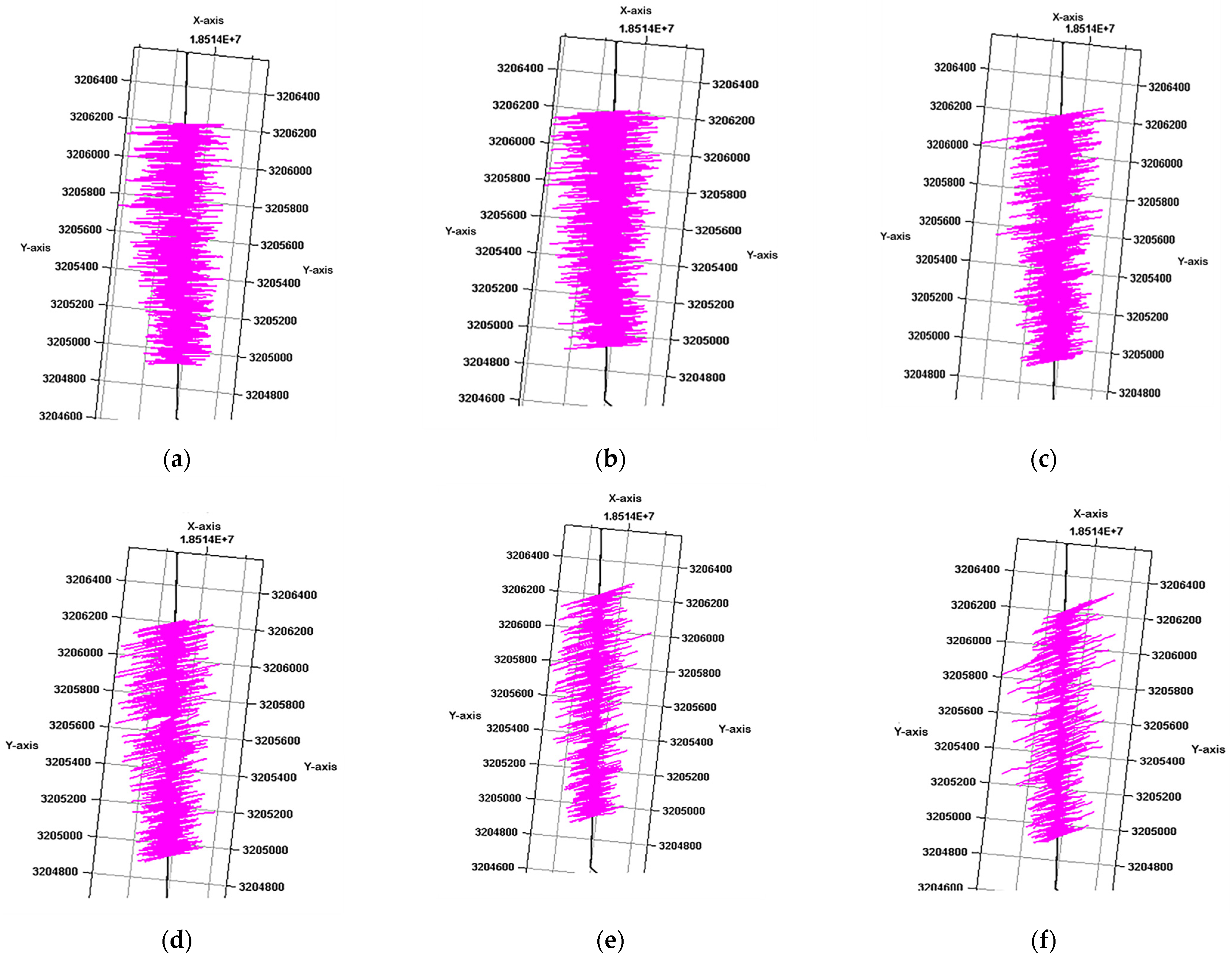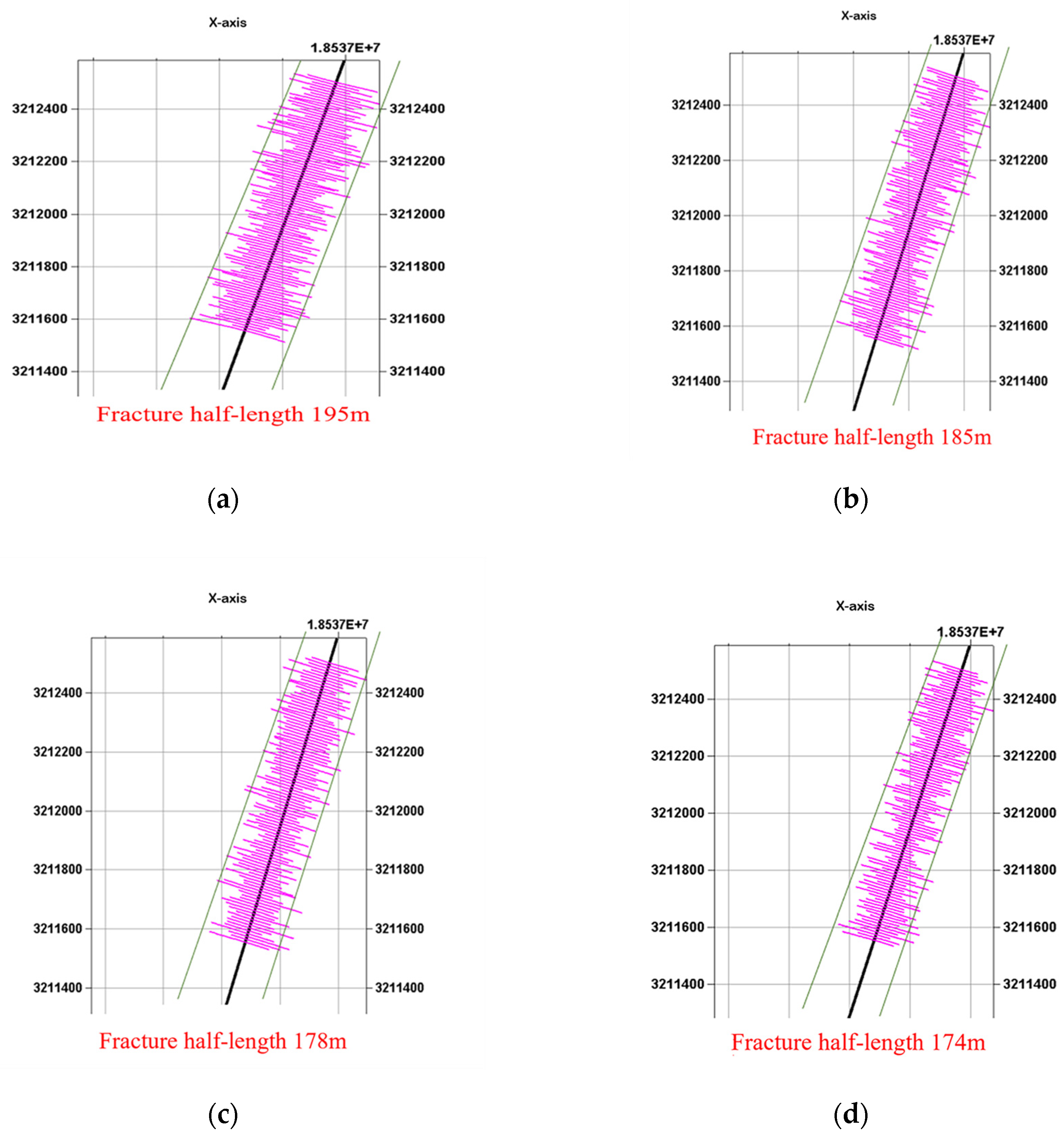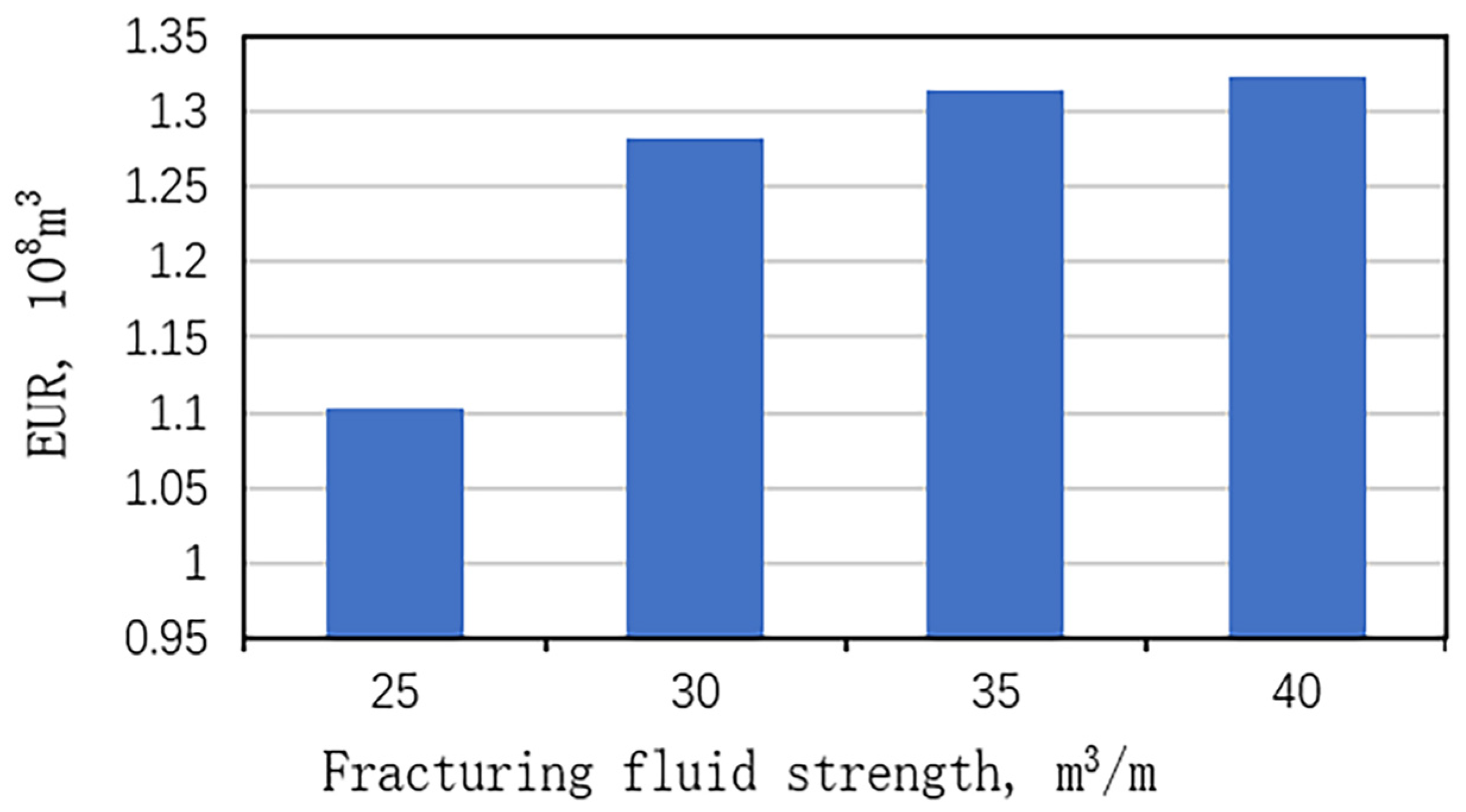Research on Geological-Engineering Integration Numerical Simulation Based on EUR Maximization Objective
Abstract
:1. Introduction
Motivation
2. Model Development
3. Model Implementation and Discussion
3.1. Parameters Setting and History Fitting of Typical Well Model
3.2. Optimization of Well Platform Parameters
3.3. Optimization of Fracturing Fluid Strength
3.4. Optimization of Sand Addition Strength
3.5. Optimization of Construction Displacement
3.6. Orthogonal Analysis Experiment
3.7. Instance Application
4. Conclusions
- By using the integrated geological-engineering simulation method, accurate fitting of the production history of existing wells can be achieved.
- Based on the geological model of a typical well, the reasonable range of fracturing construction parameters in the adjacent area has been determined. The specific details are as follows: horizontal well length of 40~100 m, cluster spacing of 5–10 m, fracturing fluid strength of 25–40 m3/m, construction displacement of 14 m3/min–20 m3/min, and sand addition of 3 t/m–5 t/m.
- The optimal fracturing construction parameters for Class II reservoirs have been determined by using the orthogonal experimental method. The primary and secondary relations of the parameters are sorted, that is: (1) sand addition strength, (2) cluster spacing, (3) construction displacement, (4) fracture fluid strength, and (5) horizontal segment length.
- The screened fracturing construction parameters are used for integrated simulation. The comparison between simulation results and the actual well data verifies the correctness of the selected construction parameters.
Author Contributions
Funding
Data Availability Statement
Conflicts of Interest
Nomenclature
| EUR | estimated ultimate recovery, m3; |
| the sum of the experimental indicators corresponding to the level m of the jth influencing factor; | |
| the average of ; | |
| Rj | the range of the jth influencing factor that eliminates the numerical influence; |
| the experimental indicator value corresponding to the level m of the jth influencing factor; | |
| the difference between the different levels of the jth influencing factor. |
References
- Hu, H.Y.; He, Z.D.; Chen, B.C. Accumulated Conditions of Shale Gas in the Middle-Low Palaeozoic, Yangtze Platform, China. Adv. Mater. Res. 2012, 524–527, 122–125. [Google Scholar]
- Huang, J.; Zou, C.; Li, J.; Dong, D.; Wang, S.; Wang, S.; Cheng, K. Shale gas generation and potential of the Lower Cambrian Qiongzhusi Formation in the Southern Sichuan Basin, China. Pet. Explor. Dev. 2012, 39, 75–81. [Google Scholar] [CrossRef]
- Tang, H.-M.; Wang, J.-J.; Zhang, L.-H.; Guo, J.-J.; Chen, H.-X.; Liu, J.; Pang, M.; Feng, Y.-T. Testing method and controlling factors of specific surface area of shales. J. Pet. Sci. Eng. 2016, 143, 1–7. [Google Scholar] [CrossRef]
- Liu, Y.; Jin, J.; Pan, R.; Li, X.; Zhu, Z.; Xu, L. Normal Pressure Shale Gas Preservation Conditions in the Transition Zone of the Southeast Basin Margin of Sichuan Basin. Water 2022, 14, 1562. [Google Scholar] [CrossRef]
- Wan, C.; Song, Y.; Li, Z.; Jiang, Z.; Zhou, C.; Chen, Z.; Chang, J.; Hong, L. Variation in the brittle-ductile transition of Longmaxi shale in the Sichuan Basin, China: The significance for shale gas exploration. J. Pet. Sci. Eng. 2022, 209, 109858. [Google Scholar] [CrossRef]
- Yang, P.; Yu, Q.; Mou, C.; Wang, Z.; Liu, W.; Zhao, Z.; Liu, J.; Xiong, G.; Deng, Q. Shale gas enrichment model and exploration implications in the mountainous complex structural area along the southwestern margin of the Sichuan Basin: A new shale gas area. Nat. Gas Ind. B 2021, 8, 431–442. [Google Scholar] [CrossRef]
- He, X.; Chen, G.; Wu, J.; Liu, Y.; Wu, S.; Zhang, J.; Zhang, X. Deep shale gas exploration and development in the southern Sichuan Basin: New progress and challenges. Nat. Gas Ind. B 2023, 10, 32–43. [Google Scholar] [CrossRef]
- Dong, D.; Liang, F.; Guan, Q.; Jiang, Y.; Zhou, S.; Yu, R.; Zhang, S.; Qi, L.; Liu, Y. Development model and identification of evaluation technology for Wufeng Formation–Longmaxi Formation quality shale gas reservoirs in the Sichuan Basin. Nat. Gas Ind. B 2023, 10, 165–182. [Google Scholar] [CrossRef]
- Yuan, J.L.; Deng, J.G.; Tan, Q.; Hu, L.B. A New Calculation Method for Micro-Hole Collapse Pressure of Shale Gas Reservoirs in Thrust Fault. Appl. Mech. Mater. 2013, 318, 410–413. [Google Scholar]
- He, L.; Chen, Y.; Zhao, H.; Tian, P.; Xue, Y.; Chen, L. Game-based analysis of energy-water nexus for identifying environmental impacts during Shale gas operations under stochastic input. Sci. Total Environ. 2018, 627, 1585–1601. [Google Scholar] [CrossRef]
- She, H.; Hu, Z.; Qu, Z.; Zhang, Y.; Guo, H. Determination of the Hydration Damage Instability Period in a Shale Borehole Wall and Its Application to a Fuling Shale Gas Reservoir in China. Geofluids 2019, 2019, 3016563. [Google Scholar] [CrossRef]
- Zhao, J.; Peng, Y.; Li, Y.; Xiao, W. Analytical model for simulating and analyzing the influence of interfacial slip on fracture height propagation in shale gas layers. Environ. Earth Sci. 2015, 73, 5867–5875. [Google Scholar] [CrossRef]
- Peng, Y.; Zhao, J.; Sepehrnoori, K.; Li, Z. Fractional model for simulating the viscoelastic behavior of artificial fracture in shale gas. Eng. Fract. Mech. 2020, 228, 106892. [Google Scholar] [CrossRef]
- Li, Z.; Duan, Y.; Peng, Y.; Wei, M.; Wang, R. A laboratory study of microcracks variations in shale induced by temperature change. Fuel 2020, 280, 118636. [Google Scholar] [CrossRef]
- Peng, Y.; Luo, A.; Li, Y.; Wu, Y.; Xu, W.; Sepehrnoori, K. Fractional model for simulating Long-Term fracture conductivity decay of shale gas and its influences on the well production. Fuel 2023, 351, 129052. [Google Scholar] [CrossRef]
- Yong, R.; Chen, G.; Yang, X.; Huang, S.; Li, B.; Zheng, M.; Liu, W.; He, Y. Profitable development technology of the Changning-Weiyuan National Shale Gas Demonstration Area in the Sichuan Basin and its enlightenment. Nat. Gas Ind. B 2023, 10, 73–85. [Google Scholar] [CrossRef]
- Hu, P.; Geng, S.; Liu, X.; Li, C.; Zhu, R.; He, X. A three-dimensional numerical pressure transient analysis model for fractured horizontal wells in shale gas reservoirs. J. Hydrol. 2023, 620, 129545. [Google Scholar] [CrossRef]
- Ning, Y.; Zhang, K.; He, S.; Chen, T.; Wang, H.; Qin, G. Numerical modeling of gas transport in shales to estimate rock and fluid properties based on multiscale digital rocks. Energy Procedia 2019, 158, 6093–6098. [Google Scholar] [CrossRef]
- Rao, X.; Zhan, W.T.; Zhao, H.; Xu, Y.F.; Liu, D.; Dai, W.X.; Gong, R.; Wang, F. Application of the least-square meshless method to gas-water flow simulation of complex-shape shale gas reservoirs. Eng. Anal. Bound. Elem. 2021, 129, 39–54. [Google Scholar] [CrossRef]
- Shin, H.; Nguyen-Le, V.; Kim, M.; Shin, H.; Little, E. Development of Production-Forecasting Model Based on the Characteristics of Production Decline Analysis Using the Reservoir and Hydraulic Fracture Parameters in Montney Shale Gas Reservoir, Canada. Geofluids 2021, 2021, 6613410. [Google Scholar] [CrossRef]
- Sun, H.; Yao, J.; Gao, S.H.; Fan, D.Y.; Wang, C.C.; Sun, Z.X. Numerical study of CO2 enhanced natural gas recovery and sequestration in shale gas reservoirs. Int. J. Greenh. Gas Control 2013, 19, 406–419. [Google Scholar] [CrossRef]
- Du, X.; Li, Q.; Xian, Y.; Lu, D. Fully implicit and fully coupled numerical scheme for discrete fracture modeling of shale gas flow in deformable rock. J. Pet. Sci. Eng. 2021, 205, 108848. [Google Scholar] [CrossRef]
- Ibrahim, A.F. Integrated workflow to investigate the fracture interference effect on shale well performance. J. Pet. Explor. Prod. Technol. 2022, 12, 3201–3211. [Google Scholar] [CrossRef]
- Al Shehhi, H.A.A.; Bernadi, B.; Belal Al Shamsi, A.B.Z.; Al Hammadi, S.J.; Alawadhi, F.O.; Mohamed, I.N.; Al Bairaq, A.M.; Al Hosani, M.A.; Abdullayev, A.; Roopal, A. Advanced Well Completion Strategies to Improve Gas Production Deliverability in Marginal Tight Gas Reservoirs from an Onshore Abu Dhabi Gas Field. In Proceedings of the Abu Dhabi International Petroleum Exhibition Conference, Abu Dhabi, United Arab Emirates, 15–18 November 2021. [Google Scholar]
- Yong, R.; Wu, J.; Shi, X.; Zhuang, X.; Wen, H.; Luo, Y. Development Strategy Optimization of Ning201 Block Longmaxi Shale Gas. In Proceedings of the SPE International Hydraulic Fracturing Technology Conference and Exhibition, Muscat, Oman, 16–18 October 2018. [Google Scholar]
- Belhaj, H.; Dhabi, A.; Mnejja, M. Hydraulic Fracture Simulation of Two-Phase Flow: Discrete Fracture Modelling/Mixed Finite Element Approach. In Proceedings of the SPE Reservoir Characterisation and Simulation Conference and Exhibition, Abu Dhabi, United Arab Emirates, 9–11 October 2011. [Google Scholar]
- Shang, X.F.; Zhao, H.W.; Long, S.X.; Duan, T.Z. A Workflow for Integrated Geological Modeling for Shale Gas Reservoirs: A Case Study of the Fuling Shale Gas Reservoir in the Sichuan Basin, China. Geofluids 2021, 2021, 6504831. [Google Scholar] [CrossRef]
- Fan, D.; Ettehadtavakkol, A. Semi-analytical modeling of shale gas flow through fractal induced fracture networks with microseismic data. Fuel 2017, 193, 444–459. [Google Scholar] [CrossRef]
- Deng, H.C.; Zhou, W.; Zhou, Q.M.; Chen, W.L.; Zhang, H.T. Quantification characterization of the valid natural fractures in the 2nd Xu Member, Xinchang gas field. Acta Petrol. Sin. 2013, 29, 1087–1097. [Google Scholar]
- Jiang, T.T.; Zhang, J.H.; Wu, H. Impact analysis of multiple parameters on fracture formation during volume fracturing in coalbed methane reservoirs. Curr. Sci. 2017, 112, 332–347. [Google Scholar] [CrossRef]
- Song, H.; Hu, Y.; Luo, E.; He, C.; Zeng, X.; Zhang, S. Analysis and Application of Fractured Carbonate Dual-Media Composite Reservoir Model. Geofluids 2022, 2022, 6785373. [Google Scholar] [CrossRef]
- Mahmoud, M.; Aleid, A.; Ali, A.; Kamal, M.S. An integrated workflow to perform reservoir and completion parametric study on a shale gas reservoir. J. Pet. Explor. Prod. Technol. 2020, 10, 1497–1510. [Google Scholar] [CrossRef]
- Will, J.; Eckardt, S. Optimization of Hydrocarbon Production from Unconventional Shale Reservoirs using Numerical Modelling. Int. J. Pet. Technol. 2017, 4, 14–23. [Google Scholar] [CrossRef]
- Xu, W.; Yu, H.; Micheal, M.; Huang, H.; Liu, H.; Wu, H. An integrated model for fracture propagation and production performance of thermal enhanced shale gas recovery. Energy 2023, 263, 125682. [Google Scholar] [CrossRef]
- Zeng, B.; Liu, J.; Song, Y.; Zhou, X.; Guo, X.; Zhao, Z.; Li, M.; Zhou, F. Optimization of Fracturing Parameters in Changning Shale Based on a New Comprehensive Multi-Factor Analysis Method. In Proceedings of the ASME 2021 40th International Conference on Ocean, Offshore and Arctic Engineering, Virtual, 21–30 June 2021. [Google Scholar]
- Abrams, A. Mud Design To Minimize Rock Impairment Due To Particle Invasion. J. Pet. Technol. 1977, 29, 586–592. [Google Scholar] [CrossRef]























| Layer | L1 | L2 | L3 | L4 | F5 |
|---|---|---|---|---|---|
| Porosity, % | 5.40 | 5.30 | 5.20 | 4.80 | 4.00 |
| Toc, % | 6.20 | 5.20 | 3.80 | 2.10 | 2.10 |
| Young’s Modulus, GPa | 34.21 | 34.23 | 35.67 | 35.85 | 42.32 |
| Gas Content, m3/t | 9.30 | 8.20 | 6.70 | 5.70 | 4.20 |
| Brittle Mineral Content, % | 57.60 | 68.90 | 55.60 | 61.40 | 73.20 |
| Breakdown Pressure, MPa | 110.90 | 109.50 | 109.80 | 108.70 | 115.30 |
| Favorable Area | Reservoir Thickness | Porosity | Gas Saturation | Adsorption Gas Content | Rock Density |
|---|---|---|---|---|---|
| m | % | % | m3/t | g/cm3 | |
| I | 17.4 | 5.6 | 66 | 2.2 | 2.5 |
| II | 12.7 | 3.7 | 49 | 2.4 | 2.6 |
| Favorable Area | Area | Adsorbed Gas Storage Capacity | Free Gas Reserves | Geological Reserves | Reserve Abundance |
| km2 | 108 m3 | 108 m3 | 108 m3 | 108 m3/km2 | |
| I | 780 | 729.8 | 1902.6 | 2632.4 | 3.4 |
| II | 216 | 167.8 | 191.8 | 359.5 | 1.8 |
| Number | Displacement, m3/min | Fracturing Fluid Strength, m3/m | SandAddition, t/m | Segment Length, m | Cluster Spacing, m |
|---|---|---|---|---|---|
| 1 | 14 | 25 | 3 | 40 | 6 |
| 2 | 14 | 30 | 3.4 | 60 | 7 |
| 3 | 14 | 35 | 3.8 | 80 | 8 |
| 4 | 14 | 40 | 4.2 | 100 | 9 |
| 5 | 16 | 25 | 3.4 | 80 | 9 |
| 6 | 16 | 30 | 3 | 100 | 8 |
| 7 | 16 | 35 | 4.2 | 40 | 7 |
| 8 | 16 | 40 | 3.8 | 60 | 6 |
| 9 | 18 | 25 | 3.8 | 100 | 7 |
| 10 | 18 | 30 | 4.2 | 80 | 6 |
| 11 | 18 | 35 | 3 | 60 | 9 |
| 12 | 18 | 40 | 3.4 | 40 | 8 |
| 13 | 20 | 25 | 4.2 | 60 | 8 |
| 14 | 20 | 30 | 3.8 | 40 | 9 |
| 15 | 20 | 35 | 3.4 | 100 | 6 |
| 16 | 20 | 40 | 3 | 80 | 7 |
| Level | Displacement | Fracturing Fluid Strength | Sand Addition | Segment Length | Cluster Spacing |
|---|---|---|---|---|---|
| K1(×108) | 2.18 | 2.11 | 2.14 | 1.41 | 1.63 |
| K2(×108) | 2.06 | 2.34 | 2.52 | 2.36 | 2.31 |
| K3(×108) | 2.36 | 2.31 | 2.19 | 2.44 | 2.55 |
| K4(×108) | 1.99 | 1.83 | 1.74 | 2.38 | 2.1 |
| 1(×108) | 0.55 | 0.53 | 0.54 | 0.35 | 0.41 |
| 2(×108) | 0.52 | 0.59 | 0.63 | 0.59 | 0.58 |
| 3(×108) | 0.59 | 0.58 | 0.55 | 0.61 | 0.64 |
| 4(×108) | 0.50 | 0.46 | 0.44 | 0.60 | 0.53 |
| Optimum Level | 18 m3/min | 30 m3/m | 3.4 t/m | 80 m | 8 m |
| Rj(×108) | 0.05 | 0.03 | 0.49 | 0.01 | 0.12 |
| Primary and Secondary Sequences | Sand Addition > Cluster Spacing > Displacement > Fracturing Fluid Strength > Segment Length | ||||
| Construction Parameters | Normal Intensity | Casing Damage Situation |
|---|---|---|
| Horizontal Segment Length | 80 m | 80~100 m |
| Cluster Spacing | 8 m | ≥10 m |
| Fluid Strength | 30 m3/m | 20~25 m3/m |
| Sand Addition Strength | 3.4 t/m | 2.5~3 t/m |
| Construction Displacement | 18 m3/min | 14~16 m3/min |
Disclaimer/Publisher’s Note: The statements, opinions and data contained in all publications are solely those of the individual author(s) and contributor(s) and not of MDPI and/or the editor(s). MDPI and/or the editor(s) disclaim responsibility for any injury to people or property resulting from any ideas, methods, instructions or products referred to in the content. |
© 2024 by the authors. Licensee MDPI, Basel, Switzerland. This article is an open access article distributed under the terms and conditions of the Creative Commons Attribution (CC BY) license (https://creativecommons.org/licenses/by/4.0/).
Share and Cite
Chen, H.; Liu, H.; Shen, C.; Xie, W.; Liu, T.; Zhang, J.; Lu, J.; Li, Z.; Peng, Y. Research on Geological-Engineering Integration Numerical Simulation Based on EUR Maximization Objective. Energies 2024, 17, 3644. https://doi.org/10.3390/en17153644
Chen H, Liu H, Shen C, Xie W, Liu T, Zhang J, Lu J, Li Z, Peng Y. Research on Geological-Engineering Integration Numerical Simulation Based on EUR Maximization Objective. Energies. 2024; 17(15):3644. https://doi.org/10.3390/en17153644
Chicago/Turabian StyleChen, Haoqi, Hualin Liu, Cheng Shen, Weiyang Xie, Taixin Liu, Junfu Zhang, Jiangnuo Lu, Zhenglan Li, and Yu Peng. 2024. "Research on Geological-Engineering Integration Numerical Simulation Based on EUR Maximization Objective" Energies 17, no. 15: 3644. https://doi.org/10.3390/en17153644




